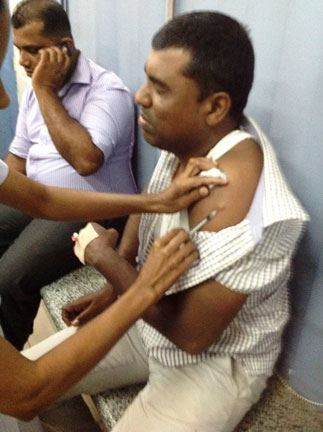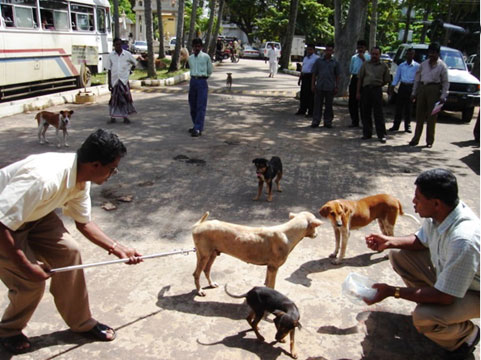Rabies: fatal but preventable
by Carol Aloysius
World Rabies Day observed on September 28 drove home some hard facts
about this disease which is still shrouded by myths and continues to
remain a threat to thousands of Sri Lankans who are constantly exposed
to the danger of being bitten by rabid dogs.
 Director Rabies Control Unit Dr P.A.L. Harischandra tells the Sunday
Observer how this remarkable turnaround was achieved, while discussing
symptoms of the disease and how to prevent it. Director Rabies Control Unit Dr P.A.L. Harischandra tells the Sunday
Observer how this remarkable turnaround was achieved, while discussing
symptoms of the disease and how to prevent it.
Excerpts...
Q: Rabies is one of the most widely prevalent diseases
worldwide. Yet many people constantly exposed to its danger
misunderstand it. What is Rabies?
A: Rabies is a disease caused by a virus belonging to the
rhabdovirus group. Rabies can infect animals as well as humans. Animal
rabies can occur among a wide range of warm blooded animals both
domestic and wild dogs, cats, cows, giant squirrels, bandicoots,
mongoose etc. Humans get the disease from animals. Hence it is a
zoonotic disease, which means that an animal who has the disease can
pass it on to humans. Rabies is present on all continents in the world
with the exception of Australia. However over 95% of deaths occur in
Asia and Africa. 95% of human rabies occurs due to infected dogs. 59,000
human rabies deaths occur world-wide annually.
Dogs are the main host and transmitter of rabies. With the number of
human rabies deaths peaking to nearly 400 in the early seventies in Sri
Lanka human rabies was made notifiable since1972.
Q: Is there a difference between human rabies and animal
rabies?
A. There is no difference in terms of fatality as both humans
and animals will die once symptoms develop. However Rabies though a 100%
deadly disease, is also100% vaccine preventable.
Q: What are the signs and symptoms of the disease in dogs and
humans? Are they very different?
A. The signs and symptoms are also very much similar with
change of behavior, agitation, drooling and paralysis. 75% of dog rabies
are paralytic and only 25% is furious. On the other hand 75% of human
rabies is furious.
Q: How do they transmit the disease to humans?
A. Transmission of Rabies is commonly through infected saliva
of an infected animal entering the body of another animal or human via
bites, scratches or licks on broken skin and mucous membranes. The
rabies virus which is present in the saliva will enter the wound site,
once it reaches the nervous tissue it attacks the central nervous system
giving rise to the symptoms and signs of encephalitis.
Q: How long does it take for symptoms to present?
|

Human vaccination against Rabies |
A. The time between the exposure occurrence and the signs of
rabies is called the incubation period.
The incubation period is typically 1-3 months, but may vary from
below 1 week to over 1 year. The incubation period depends on factors
such as location of rabies entry (eg. Site of bite) and rabies viral
load that entered the wound. The initial symptoms of rabies are fever
and often pain or an unusual or unexplained tingling, pricking or
burning sensation (paraesthesia) at the wound site. As the virus spreads
through the central nervous system, progressive, fatal inflammation of
the brain and spinal cord develops.
Q: You mentioned that Rabies can manifest itself in two forms
in humans , namely, furious and paralytic ( dumb) rabies , depending on
which symptoms develop in an infected person. What are these symptoms
and how can one identify them?
A. Furious rabies is the commonest form, exhibiting signs of
hyperactivity, excited behaviour, hydrophobia (fear of water) and
sometimes aerophobia (difficulty in breathing). After a few days, death
occurs by cardio respiratory arrest. Paralytic rabies occurs in about
30% of the total number of human cases. This form of rabies has a less
agitated and usually longer course than the furious form. The muscles
gradually become paralyzed, starting at the site of the bite or scratch.
A coma slowly develops, and eventually death occurs.
Q: How is rabies diagnosed? Can one diagnose the disease
before its onset?
A. Unfortunately there are no tests available to diagnose
rabies infection in humans before the onset of clinical disease.
Q: So how is it diagnosed eventually? After the patient has
died? Or while having the symptoms?
A. It can be confirmed post mortem by various diagnostic
techniques which detect whole virus, or viral antigens.
Q: Vaccinations against rabies - how effective are they in
preventing rabies? Can they cure rabies as well?
A. Rabies vaccines and Immunoglobulin can only prevent rabies
if it is given to the victim before the virus reaches the nervous system
that is immediately after bite. Vaccination cannot cure rabies once the
clinical symptoms appear in the victim. Vaccinating dogs is the most
cost-effective strategy for preventing rabies in people.
Q: Why?
A. Dog vaccination will reduce not only the deaths due to
rabies but also the need for Post Exposure Prophylaxis as a part of dog
bite patient care. This is a key benefit as the government at present
spends around four hundred million rupees annually for animal bite
treatments.
Q: What about preventive immunization in humans? When do you
recommend it and who are your target groups?
|

Dr P.A.L. Harischandra |
A. Pre-exposure immunization is recommended for people in
certain high-risk occupations such as laboratory workers dealing with
live rabies and other rabies-related viruses, and people involved in any
activities that might bring them into direct contact with bats,
carnivores, and other mammals in rabies-affected areas.
Q: What about children who constantly play with dogs? Aren't
they vulnerable to rabies exposure as well?
A. Yes, children are at higher risk because they tend to play
with animals and may thus receive more severe bites from these animals,
which they may not report. Therefore children wherever they live must be
educated not to play with unknown dogs.
Q: The term Post-exposure prophylaxis (PEP.) is used for
rabies treatment. What is it? When is it given?
A. Post-exposure prophylaxis (PEP) treatment is given to a
person who has been bitten. Ideally this is started immediately after
exposure in order to prevent rabies from entering the central nervous
system.
Q: What is the procedure you usually follow?
A. When a patient with bites is admitted local treatment of
the wound is initiated as soon as possible after exposure. First -aid of
rabies prevention includes immediate and thorough washing of the wound
for a minimum of 15 minutes with soap and running water. Thereafter, a
course of Anti Rabies Vaccine (ARV) is very important to complete the
whole course of vaccinations as recommended by the doctor, otherwise the
patient may not be fully protected against rabies. If indicated, Rabies
Immunoglobulin (RIG) is also inoculated in the patient.
Q: You have been spearheading innovative rabies control
programmes for several years in Sri Lanka. What are the more recent
changes in the program?
A. Public Health veterinary services in the Ministry of Health
have been spearheading innovative rabies control programers for the past
30 years in Sri Lanka to reach lowest incidence of human rabies in 2016.
Dog population control strategy was changed to animal birth control
program and adoption of responsible dog ownership.
|

Dog vaccination against dogs |
Since the new changes go beyond the scope of health service, a new
strategy was developed to launch joint programs with the Ministry of
Rural Development and Ministry of Provincial Council and Local
Government.
Q: Under the National Strategic plan to Eliminate Rabies, your
goal is to achieve that target by the year 2020. Given the obstacles you
still face, is that possible?
A. We have statistics to prove that rabies control measures
since 1975 have drastically slashed the number of human rabies deaths.
The dedicated involvement of stakeholders to implement new strategy will
make rabies elimination feasible and possible.
Q: Examples?
A. The number of human rabies deaths declined from 377 in 1973
to 24 in 2015. As of 20th September the number of deaths are 12 for
2016. Strengthening animal birth control activities and mass rabies
vaccination of dogs with the support of stakeholders of Animal health
and Local Government sectors, we are confident that rabies elimination
can be achieved by 2020
Colombo being one of the most overpopulated cities with its dense
population and the presence of large numbers of community dogs roaming
the streets, was considered one of the most vulnerable cities at risk to
this deadly disease.
In a recent interview, Colombo Municipal Veterinary Unit Chief Dr
Vipula Dharmawansa told the Sunday Observer the number of rabies
positive dogs had now declined dramatically. He said, "Before the year
2000, there were fifty positive cases of rabid dogs in the city.
The number plunged drastically to a mere three in 2015. As of now the
figure stands at zero. This year so far no cases of rabies have been
reported. If we can sustain this zero score for the next three years, we
can declare Colombo city to be Rabies Free by the year 2018."
(pix from Rabies Control Unit) |

